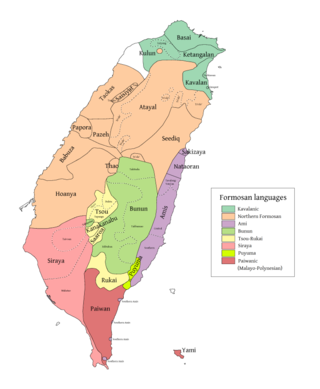Top Qs
Timeline
Chat
Perspective
Kavalan language
East Formosan language of Taiwan From Wikipedia, the free encyclopedia
Remove ads
Kavalan (also known as Kvalan, Kebalan or Kbalan) was formerly spoken in the Northeast coast area of Taiwan by the Kavalan people (噶瑪蘭). It is an East Formosan language of the Austronesian family.[3]
This article should specify the language of its non-English content using {{lang}} or {{langx}}, {{transliteration}} for transliterated languages, and {{IPA}} for phonetic transcriptions, with an appropriate ISO 639 code. Wikipedia's multilingual support templates may also be used. (March 2021) |
Kavalan is no longer spoken in its original area. As of 1930, it was used only as a home language. As of 1987, it was still spoken in Atayal territories. In 2000, this language was still reported to be spoken by 24 speakers but considered moribund.
In 2017, a study using the EDGE metric from species conservation found that Kavalan, although critically endangered, was among the most lexically distinct of Austronesian languages.[4]
Remove ads
Dialects
Kavalan consists of the following speech communities ordered from north to south:[5]
- Kariawan (Jialiwan 加禮宛) – near Hualien, a formerly Sakizaya-speaking area
- Patʀungan (Xinshe 新社) – located in Fungpin (豐濱鄉), Hualien
- Kulis (Lide 立德)
- Kralut (Zhangyuan 樟原)
These speech communities in eastern Taiwan were named after older settlements from the north, such as Kariawan, Sahut, and Tamayan, where the Kavalan people originally migrated from. Modern-day Kavalan speakers are surrounded by the Amis.
Tsuchida (1985) notes that word lists collected from Lamkham 南崁 (Nankan) and Poting 埔頂 (Buding) are closest to Kavalan,[6] while Li (2001) counts them as 'Basaic' languages.[7]
Many Kavalan can also speak Amis, Taiwanese, Mandarin, and Japanese.[5]
Remove ads
Phonology
There are 15 consonants and 4 vowels in Kavalan.[8]
In Kavalan, Proto-Austronesian phonemes have merged as follows:[9]
- *n, *N, *j, *ɲ as n
- *t, *T, *c as t
- *d, *D, *Z as z
- *s, *S as s
- *q, *ʔ, *H are deleted
The following Proto-Austronesian phonemes are split:
- *k into q and k
- *l into r and ʁ (written as R)
- *a into i (if adjacent to q) and a
The Kavalan language is also notable for having a large inventory of consonant clusters. It is also one of the only two Formosan languages that has geminate consonants, with the other one being Basay.[10] Consonant gemination is also common in the northern Philippine languages, but is non-existent in the Central Philippine languages except for Rinconada Bikol.[11]
Remove ads
Grammar
Summarize
Perspective
Morphology
Kavalan nouns and verbs are distinguished by the lack of /a/ in the first syllable (nouns) or presence of /a/ (verbs).[9] Kavalan syllables take on the structure (C)(C)V(C)(C).[12] Kavalan is also one of two Formosan languages to have geminating consonants.
Kavalan affixes include:
- m- (agent focus)
- -um-/-m- (agent focus)
- -in/-n- as variants of ni- (patient)
- -a (irrealis patient-focus marker)
- -an (locative-focus marker, nominalizer)
- -i (imperative, patient focus)
- pa- (causative)
- qa- (future)
Unlike many other Formosan languages, there is no *-en suffix.
Syntax
Kavalan, like most other Formosan and Philippine languages, has many case markers.
- Nominative: a/ya
- Oblique: ta, tu
- Genitive: na, ni
- Locative: sa, ta- -an
Types of focus in Kavalan include:[13]
- Agent
- Patient
- Locative
- Instrumental
- Beneficiary
The Kavalan case markers below are from Li & Tsuchida (2006:27).
Pronouns
The Kavalan Personal pronouns below are from Li & Tsuchida (2006:30).
Affixes
Summarize
Perspective
The Kavalan affixes below are from Li & Tsuchida (2006:14–24).
- Prefixes
- i-: stative, having to do with location
- kar-: rapid motion; defective, not perfect
- ki-, qi-: pluck, pick
- kin-: number of humans
- lu-: flat
- luq(e)-: bumpy, rough (used with stative verbs)
- m-, -m-, mu-, -u-, -um-: agent-focus
- ma-, m-: stative
- maq-: where from
- mar-: sine kind of shape
- mi-: discharge something from the body
- mri-: settle down; to shrink, huddle up
- mrim-: a division of (a numeral)
- nan-: two people (kinship); distributive numeral
- ni-, n-, -in-, -n-: past, perfective
- pa-: causative (used with active verbs)
- pa- -an: agentive
- pa-ti: personal marker for the dead
- paq-, paqa-: causative (used with stative verbs)
- paq-: get on (a boat)
- pa-qi-: cause to become
- pat-: make a change
- pi-: put into, put away; do something to protect a body part; every (time)
- qa-: immediate future; ride, take (means of transportation)
- qa- -an: place of/for
- qaRu-: become, transform into; transformable into
- qi-: pick, gather, get
- qna-: nominaizer (used with stative verbs; -an is used with active verbs)
- Ra-: to transform into
- Ra-CV-: light color of
- Ri-: catch, get
- Ru-: just now; for the first time
- sa-: have the event (natural phenomena); do, make, produce, have; secrete (body fluid); tool
- sam-CV-: pretend
- saqa-: ordinal (numeral)
- si-: wear, own, possess
- sia-: go towards (place/direction); go to the side (often euphemistic for urinating/defecating)
- sim-: reciprocal
- siqa-: (number of) times
- smu-: finger
- sna-: model of, copy of
- su-: remove; move downwards, upside down, slanting
- su-CV-: stink or smell of
- tan-: speak the language
- taRi-: position, people in such a position
- ti-: instrumental-focus; to take each other (?)
- ti- (-an): beneficiary-focus
- tRi-CV(C)- (-an): discharge (body discharge) with control
- u-: agent-focus; non-human numeral
- Suffixes
- -a: irrealis patient-focus marker
- -an: locative-focus marker, nominalizer
- -i: irrealis non-agent-focus imperative
- Infixes
- -m-, -um-: agent-focus
- -n-, -in-, ni-: perfective
Remove ads
References
External links
Wikiwand - on
Seamless Wikipedia browsing. On steroids.
Remove ads


